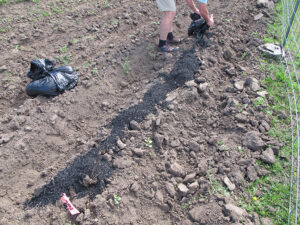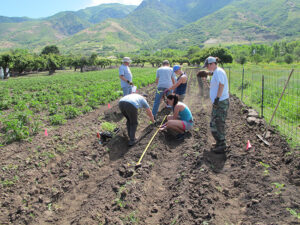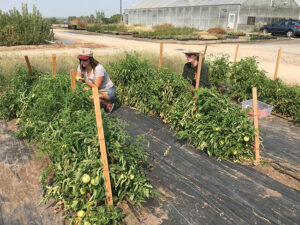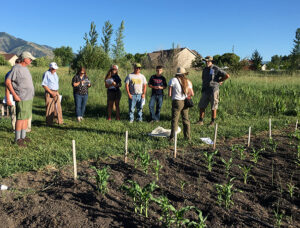Final report for OW14-036
Project Information
When biomass such as wood, agricultural residue, manure, algae, etc., is super-heated in an enclosed system (called pyrolysis), three products may be created: bio-oil, synthetic gas, and biochar. The biochar product is a carbon-rich material that has been researched world-wide as a potential soil amendment. Vegetable producers in Utah expressed an interest in learning more about biochar to improve irrigation and nutrition management on crops grown in arid and alkaline soils, as well as preventing losses due to soil-borne pathogens such as Phytophthora sp. In biochar studies in other western U.S. locations, the effects on plant growth have varied among soil types, biochar production specifications, and application rates, making this project important to evaluating its value for agriculture in Utah. We worked with producers to collect fruit pruning wood to make biochar, and also used biochar as an amendment in on-farm trials to improve yield of tomato and melon. We also conducted greenhouse trials to determine biochar-grown tomato and melon susceptibility to Phytophthora root rot. In the field trials, soil pH and salinity remained largely unchanged after three years, while some nutrient increased and some decreased. In addition, there was no significant tomato or melon yield increase by the third season. In the greenhouse trial, we found no significant reduction in root rot symptoms from the application of biochar to the growth media. We conclude that although biochar has merits as a carbon sequestration tool, and for fresh tomato production, the yield increase will outweigh the cost of the biochar application in the first three years, there are still unknowns on the long-term effects of biochar for vegetable production.
1) Evaluate soil application rates of fruit wood-prepared biochar for field-grown tomatoes and melons and establish parameters for subsequent trials.
2) In collaboration with producers, evaluate how biochar amendment at the identified optimal rate influences crop yield of tomato and melon.
3) Determine whether the same rate of biochar used in objective 2, when mixed in potting media, prevents or reduces susceptibility of pot-grown tomato and melon to Phytophthora root rot.
4) Determine whether the use of soil-applied biochar could provide economic benefits to Utah’s vegetable growers.
Cooperators
Research
Objective 1) Evaluate soil application rates of fruit wood-prepared biochar for field-grown tomatoes and melons and establish parameters for subsequent trials.
The fruit producer we worked with supplied pruning wood as a source of biochar for this project, as we were hoping that orchardists could use wood waste as a sustainable source for biochar production. In spring 2014, he supplied 100 pounds of cherry wood, delivered to Western Renewables Technology (WRT) in Lindon, UT. WRT produced biochar batches representing three different pyrolysis temperatures of 375°C, 475°C, and 575°C.
In summer 2014, lettuce (Parris Island Cos) was grown in 3-gallon plastic pots filled with silt loam field soil, and amended with 4-4-4 organic fertilizer and biochar. The ten biochar treatments included the three temperatures listed above, each mixed into the soil at 1%, 2%, and 3% by weight, and no biochar. Lettuce was chosen for its quick time to maturity. After nine weeks of growth with normal irrigation, mean dry weight (g) of plants was measured and compared.
Objective 2) Evaluate how biochar amendment at the identified optimal rate influences crop yield of tomato and melon.
In 2015, our fruit producer cooperator created and supplied a pile of 2,000 lbs of cherry pruning debris. The project investigators then arranged for chipping and transporting the biomass to WRT. Due to the warm 2015 winter, trees were pruned earlier than expected, and the wood was still wet. The wetness of the wood caused WRT’s pyrolysis reactor to fail, and by late May, only 50 lbs of biochar had been produced. Because we were making a one-time application of biochar, it was essential to get a product in 2015. Therefore, we obtained additional biochar (made from beetle-killed lodgepole pine) from Confluence Energy in Colorado.
This project involved three seasons of growing tomato and melons in biochar-amended soil. Since biochar takes many years to degrade, and based off of previous studies and recommendations, it was applied only once to the farm soils, right before the spring 2015 planting. The project was intended to be conducted on four producer sites: Pettingill Farms in Box Elder County, and Zoe’s Garden, Day Farms, and the USU Botanical Center, all in Davis County. One planting block on each site contained three randomized treatments: biochar plus fertilizer, fertilizer alone, and control. There was no “biochar only” treatment because it is recommended to always use an amendment with biochar.

The biochar was incorporated at a rate of 10 tons/acre in the “broadcast-and-disk” method by first tilling the soil, broadcasting, and then lightly tilling again after application. Before each planting season, Jobe’s Organic Fertilizer (4-4-4), equivalent to approximately 60 lb of N-P-K per acre, was applied to the biochar plus fertilizer, and fertilizer-only strips, and six tomato and five melon plants were planted into each treatment. The work crew consisted of the project investigators plus the cooperating producers that were available to help.
The other setback involved the loss of the cooperator producer planting sites over the next two seasons. The Pettingill farm was accidentally tilled over by one of the producer’s laborers right before the spring 2016 planting, mixing the biochar into the treatments. On Zoe’s farm, the irrigation did not function in 2015 or 2016, and hand-watering was insufficient to keep the plants healthy in both years. And finally, the land we used on the Day Farm was unexpectedly sold in mid-summer 2016. Therefore, we were only able to collect data from three of the four sites in 2015, and just one of those sites in 2016 and 2017. The producers, however, remained engaged in the planting, pruning, harvesting, and education projects.

For each treatment and in each year, tomato plants were pruned in mid-summer, and the prunings were dried and weighed. Pink to red fruits were harvested and weighed once per week until final harvest, and a lb/plant yield was determined for each treatment. Melons were harvested in a single day for each site, and lb/plant was also determined. Right after harvest, above-ground portions of all melon and tomato plants were dried and weighed.
Objective 3) Determine whether the same rate of biochar used in objective 2, when mixed in potting media, prevents or reduces susceptibility of pot-grown tomato and melon to Phytophthora root rot.
During this greenhouse trial, four treatments were compared: soil+biochar+phytophthora inoculation, soil+biochar+water inoculation, soil+phytophthora inoculation, and soil+water inoculation. Each treatment was represented by five plants of tomato and five plants of melon, for a total of 20 plants of each type. Objective 1 of this project determined the best rate and pyrolysis temperature for our biochar. Vegetable plants were potted in 3-gal pots with standard greenhouse media, or media plus 2% biochar (by weight) produced at 375°C. Plants received standard fertigation, and were left to grow in the greenhouse for two months before inoculation.
The Phytophthora inoculum was prepared by growing plugs of mycelium from a mix of Phytophthora capsici, P. nicotianae, P. cactorum, and P. megasperma in sterilized rice for 7 days. Each plant was inoculated by placing 20 grains of rice at one inch below the soil and two inches from the stem. Plants were then soaked in water for 12 hours, and returned to normal irrigation/fertigation for four more weeks. Plants were then rated for disease, weighed, and roots were tested for the presence of Phytophthora with Agdia test kits. This trial was repeated one more time.
Objective 4) Determine whether the use of soil-applied biochar could provide economic benefits to Utah’s vegetable growers.
We used the publication and supplemental Crop Enterprise Budget sheet from Galinato, Miles, and Ponnaluru’s “2011 Cost of Producing Fresh Market Field-Grown Tomatoes in Western Washington”, to compare cost estimates and income of growing tomatoes with and without biochar. All production costs (land value, management value, labor, irrigation, supplies, fertilizer, pesticides, etc.) were unchanged in the comparison.
Objective 1) Evaluate soil application rates of fruit wood-prepared biochar for field-grown tomatoes and melons and establish parameters for subsequent trials.
Mean dry weight (g) of plants was determined after a single harvest nine weeks after seeding. Although there was a large variability in lettuce plant weights, we were able to use the data to determine the biochar pyrolysis temperature and rate for this study. Lettuce growth was decreased with the addition of biochar in all treatments except where biochar was produced at 375°C, which is a common short-term observation in similar studies. We found that lettuce plants grown in biochar produced at 375°C at 2% and 3% rates were the only treatments to exceed plant growth above the control. While other treatments had comparable yields, the 375°C is desirable because during biochar production, there is higher yield of biochar at a lower temperature. Therefore, we identified that biochar produced at 375°C and applied at a 2% rate as the target for the subsequent field study.
Objective 2) Evaluate how biochar amendment at the identified optimal rate influences crop yield of tomato and melon.
For each treatment and in each year, we determined a lb/plant yield and average dry plant weight.

In the 2015 season, we obtained data from three of the four sites. Past studies have shown that plant growth in first year of biochar-amended soil is typically inconsistent, and our results reflect this. At the Pettingill Farm site, the tomato yield was greatest in the fertilizer treatment, and was similar in both the biochar+fertilizer and control treatments. The melon yield was highest in the fertilizer treatment, and lowest in biochar+fertilizer. At the Day Farm, both melon and tomato yields were highest in the control plots and lowest in fertilizer alone.
In the 2016 and 2017 seasons, we obtained data from just one of the four sites (USU Botanical Center [BC]). Since the objective of this study was to view long-term results of biochar-amended soil, the results for the intact farm are of greater value than the results from the single season from the Pettingill and Day farms. Discussed below are results for USU BC for years 1, 2, and 3. There were trends in crop growth and yield, but there were no statistically significant differences between treatments in any of the three years.
For both melons and tomatoes, the yield and average plant weight decreased significantly from year 1 to year 3 across all treatments. This was likely due to not rotating the tomato and melon plants between treatments. We wanted to keep the crop/treatment locations the same throughout the study, but in hindsight, we should have set up the study as a crop rotation.
Tomatoes: Tomato yield across all three treatments and all three years was highest in the biochar+fertilizer treatment in year 2, at 17.5 lb/plant. In year 1, yield was very similar between the three treatments, from 13.5 to 13.9 lb/plant. In year 3, yield was highest in the biochar+fertilizer treatment again, but still very similar to the fertilizer alone treatment. Average dry weight per plant was always highest in the biochar plots, with the greatest increase in year 2, but again, not significantly higher for any year.

Melons: Melon yield across all three treatments and all three years was highest in the biochar+fertilizer treatment in year 1, at 32.6 lb/plant. In year 2, the biochar+fertilizer plants had the second-highest yield (behind fertilizer), and in year 3, the biochar+fertilizer plants had the lowest yield of the three treatments. Average dry weight per plant across all years and treatments was also highest in the biochar+fertilizer in year 1 (282 grams). In year 2, plant weight was highest in the biochar+fertilizer plots (240 grams), and in year 3, it was highest in the control (140 grams), followed by the biochar+fertilizer treatment (135 grams).
In general, the addition of the biochar resulted in a slight increase in plant weight and crop yield in some years, and decreased plant weight and crop yield in other years.
- Biochar affected melons most significantly in year 1, with a 35% increase in biomass and 18% increase in yield over fertilizer alone (24% / 27%, respectively, over the control). In year 3, the biochar plots yielded the lowest melon yield.
- Biochar affected tomatoes most significantly in year 2, with a 13% increase in biomass and 22% increase in yield over fertilizer alone (25% / 24%, respectively, over the control). The yield was similar across all three treatments in years 1 and 3.
- Averaging across all three years, melon biomass was 29% higher than the fertilizer alone, and 13% higher than the control. Melon yield was 4% higher in both the fertilizer and the control.
- Also averaging across all three years, tomato biomass was 17% higher than fertilizer alone, and 20% higher than the control. Tomato yield was 15% higher than fertilizer alone and 25% higher than the control.
We also measured soil pH, salinity, and nutrient before the char addition, and three years afterward. Soil pH increased by just 0.1 units, from 7.4 – 7.5. Salinity decreased from 0.67 dS/M to 0.51 dS/M. Phosphorus increased significantly (31 to 104 mg/kg). Nitrogen decreased (16 to 10 mg/kg), zinc increased (2 to 4 mg/kg), iron decreased (19 to 10 mg/kg), sulfur decreased (18.2 to 5 mg/kg), and organic matter increased from 2% to 4%. The soil test results collected in year 3 from the biochar+fertilizer and the fertilizer treatments, however, showed no significant differences.
Objective 3) Determine whether the same rate of biochar used in objective 2, when mixed in potting media, prevents or reduces susceptibility of pot-grown tomato and melon to Phytophthora root rot.
During this experiment, several attempts were made to determine the best inoculation procedure, with the rice grain technique being easiest to standardize and bearing the most consistent results. At the end of the growing season (approximately 12 weeks), plants were given ratings of the root system and the tops, from 0 to 5, where 0 was no visible symptoms or wilting and 5 was dead. In addition, the upper plant biomass and root biomass were dried and weighed separately.
In both trials, root rot was found on the inoculated plants in both biochar and non-biochar soil types, and no disease was found on the water-inoculated plants. The average health ratings and top and root weights for the plants growing in regular media and media plus biochar were significantly lower (health) or higher (weight) than the averages of the inoculated plants.
When comparing between the non-inoculated melon and tomato plants with and without biochar, and between the inoculated plants with and without biochar, there were no statistically significant differences in health ratings or weights. The trends were as follows:
Melons:
- Biochar plants were healthier than the non-char plants (average rating of 1.35 versus 1.85)
- Biochar-inoculated plants were healthier than non-biochar-inoculated plants (average rating of 2.75 versus 3.3)
- Biochar plants had the greatest average dry weight in their tops (7.5 g versus 6 g) and roots (38 g versus 35 g) over the non-biochar plants.
- Biochar-inoculated plants had greatest average dry weight in their tops (4 g over 2.5) and roots (28 g over 18 g) over the non-biochar-inoculated plants.
Tomatoes:
- Biochar plants were healthier than the non-biochar plants (rating of 1.3 versus 2)
- There was little difference in health ratings between the inoculated biochar and non-biochar plants (ratings of 3.4 and 3.3)
- There was little difference in average dry weight between the biochar and non-biochar plants of their top (14 and 15 g) and root weights (59 and 63 g).
- There was little difference in average dry weight between the inoculated biochar and inoculated non-biochar plants of their top (9 and 10 g) and root weights (41 and 43 g).
Objective 4) Determine whether the use of soil-applied biochar could provide economic benefits to Utah’s vegetable growers.
Because our 3-year average yield increase due to the addition of biochar (over fertilizer alone) was greater for the tomatoes (15%) than the melons (4%), we focused the economic analysis on production of fresh tomatoes for farmer’s market/CSA sale.
Using the publication and supplemental Crop Enterprise Budget from Galinato, Miles, and Ponnaluru’s “2011 Cost of Producing Fresh Market Field-Grown Tomatoes in Western Washington”, we kept all production costs (land value, management value, labor, irrigation, supplies, fertilizer, pesticides, etc.) unchanged, and adjusted the sheet for the costs of biochar and change in yield. We made the comparison for three years of production, adding the biochar cost and labor in the first year, and the per-acre yield increase for years 1, 2, and 3 that were found in this study.
The WSU Enterprise Budget has the following assumptions:
- The tomatoes are a hybrid indeterminate variety, planted at 5,500 per-acre, with a 30,360 lb yield.
- The return to the farmer is $2/lb, where fruits are sold at farmers markets or CSA.
- The results are shown for one acre of production in western Washington state.
Our assumptions:
- The change in yield with the addition of biochar would increase yield in year 1 to 31,574 (4%), in year 2 to 37,039 (22%), and in year 3 to 32,789 (8%).
- For the amount of biochar a farmer would need on one acre, we used the same rate that we applied in this study, which was 2%, or 10 tons/acre. Since biochar only needs to be banded to the planting row (in this scenario, there are 22 rows in the acre, at 4-feet wide with 5-feet between rows), enough biochar would be needed for approximately ½-acre, or approximately 5 tons.
- Although biochar could be produced on-site in a home-made kiln, we are using the farmer-cost of purchasing biochar from a production facility, such as our supplier, Confluence Energy. In our case, the cost was $525/ton. At 5 tons/acre, this would cost the grower $2,625.
- Delivery costs are not included in this comparison due to the high variability.
- For the cost of application, we used estimates determined by Williams’ and Arnot’s 2010 paper, “A Comparison of Variable Economic Costs Associated with Two Proposed Biochar Application Methods” (in Annals of Environmental Science). They found that the broadcast-and-disk method (the method used in this study) cost $160/ac.
With no changes to the Enterprise Budget, the net return using WSU’s assumptions is $34,737. In our scenario, these are the following net returns in years 1, 2, and 3, using our assumptions: $34,045; $47,552; $39,397.
Based on these results, a tomato grower would make $104,211 over three years without biochar, and $120,994 over three years with biochar. This of course, is following all assumptions provided above.
Research outcomes
Education and Outreach
Participation summary:
We prepared (or interviewed for) the following fact sheets and press, newsletter, and journal articles:
- Hunter, B. 2014. Introduction to Biochar. USU Extension Fact Sheet. 4 pp.
- Hunter, B. 2015. Biochar Uses Poster. USU Extension. Poster: What is Biochar?
- Hunter, B, G. E. Cardon, S. Olsen, D.G. Alston and D. McAvoy. 2017. Preliminary screening of the effect of biochar properties and soil incorporation rate on lettuce growth to guide research and educate the public through extension. Journal of Agricultural Extension and Rural Development. Vol.9 (1), pp. 1-4. Published journal article
- Hunter, B. 2016. Biochar Investigations in Utah. Utah Biomass Resources Newsletter. Utah State University. 2 pp.
- Loomis, J. 2015. Garden like a Boss: Biochar 101. Catalyst Magazine (interview). December. 2 pp.
- Murray, M. and B. Hunter. 2014. Biochar: An Ancient History Leads to Modern Uses. Utah Pests News. Winter 2014. 2 pp. Article on introduction to biochar
- Murray, M. and C. Cannon. 2018. Is Biochar worth it for Utah’s Vegetable Producers? Utah Pests News. Spring 2018. 3 pp. Article on Biochar in Vegetable Production
- Murray, M. and C. Cannon. 2018. Biochar in Utah Agriculture. USU Extension Fact Sheet. 3 pp. Fact sheet on biochar uses in agriculture
- Murray, M. and C. Cannon. 2018. What is Biochar and how is it Used? USU Extension Fact Sheet. 3 pp. Fact sheet on general biochar uses
- Murray, M. 2018. Biochar for Vegetable Production. Chapter in: Utah Vegetable Production and Pest Management Guide. Utah State University Extension. 4 pp.

Work on this project has also been shared through the following venues:
- National Association of County Agriculture Agents to fellow agricultural professionals (2015 in Sioux Falls and 2017 in Salt Lake City)
- American Society of Horticulture Science (2015 in New Orleans)
- SARE Our Farms, Our Future Conference (2018; poster; SARE Conference biochar poster)
- Urban and Small Farms Conference, Utah to producers (2015, 2016, and 2018)
- Vegetable grower meetings, Utah (4 total in 2016 and 2017)
- Green Industry and Vegetable webinars to producers and agricultural professionals (3 total from USU)
- Field days (2 for fruit and vegetable producers in 2015 and 2017; one planned for summer 2018)
- On-farm demonstration (20 growers shown how biochar is made, applied, and managed, 2016)
- Radio interview (2015, on the BYU Radio show Thinking Aloud)
Education and Outreach Outcomes
A survey was presented to fruit and vegetable producers at the 2016 and 2018 Utah Urban and Small Farms Conference, and was filled out by approximately 60 producers each time. They were asked if they had heard of biochar, had used biochar, and if they were interested in using or producing biochar in the future. In addition, they were asked of their understanding of what biochar is, how it may work on the soil, and effects on vegetable production.
In 2016, only 6% of producers had heard of biochar before the presentation, and in 2018, it increased to 27%. After the presentations, most of the producers (74% in 2016 and 88% in 2018) increased their general knowledge about biochar, 56% and 63% increased their knowledge about how it works in the soil, and 47% and 79% increased their knowledge about its effects on vegetable production.
In both years, none of the producers indicated that they had used biochar before. For vegetable production, a few (12% in 2016 and 21% in 2018) were interested in using biochar in the future. For biochar production from orchard debris, fewer producers were interested (4% and 8%), but those growers represent a large acreage and we are continuing a dialogue with them via board representation on the Utah State Horticultural Association.